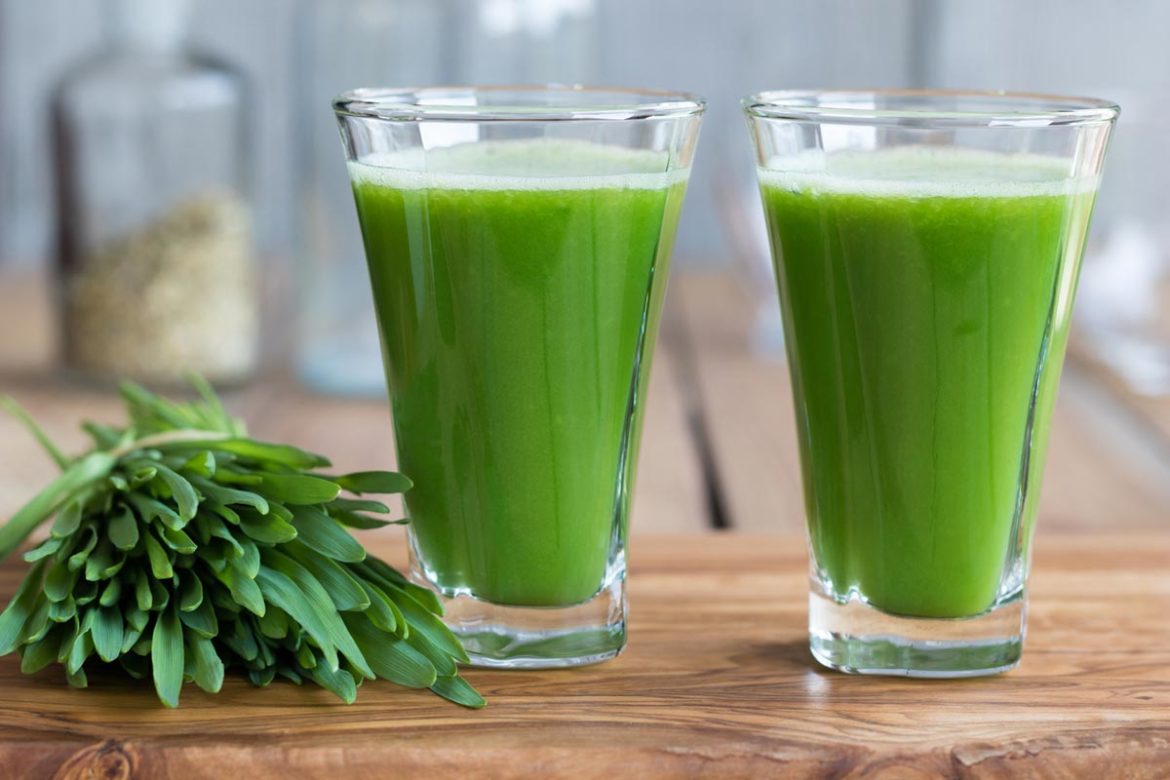Wheatgrass is an ingredient that is popping up in health food stores and juice bars.
Freshly sprouted wheat plant leaves are used in its preparation. The term ‘shots’ referred to in the title does not mean taking wheatgrass via a hypodermic needle.
Wheatgrass shots are small amounts of juice, two to four ounces, made from the tender shoots of wheat plants. They can be consumed in one or two swallows similar to the way liquor shots are downed.
The health benefits of wheatgrass are great but it has a bitter taste that makes sipping it somewhat unpleasant. The minerals and vitamins contained in wheatgrass make looking past the taste an important health benefit. Health experts recommend wheatgrass as a means of improving vitamin intake and as a natural immune or digestive problem cure. A single serving of wheatgrass contains a plateful of the wheat plant. Here are some proven benefits of wheatgrass shots.
Our favorite wheatgrass powder brands
- Dr. Berg’s Raw Wheat Grass Juice Powder
- Pure Synergy Organics Wheat Grass Juice Powder
- Amazing Grass Organic Wheat Grass
7 Reasons to take wheatgrass shots
1. High in Antioxidants and Nutrients
Wheatgrass is a source of many different minerals and vitamins. It is extraordinarily rich in amino acids, calcium, magnesium, and vitamins A, C, and E. The body cannot produce eight of the amino acids in wheatgrass. They need to come from food sources.
Vitamins C and E and glutathione are essential antioxidants found in wheatgrass. Antioxidants fight free radicals to reduce oxidative stress and prevent cell damage. Studies show antioxidants help protect against arthritis and neurodegenerative diseases, cancer, and heart disease.
2. Possible Cholesterol Reducer
Throughout the body, a waxy substance known as cholesterol is found. Some cholesterol is needed to produce bile and make hormones. Too much in the blood blocks blood flow and increases the risk of heart disease.
Still being tested, the health benefits of wheatgrass juice was found to improve cholesterol in rabbits that were fed diets high in fat. After ten weeks of wheatgrass supplements, there was a decrease in total cholesterol and an increase in ‘good’ HDL cholesterol.
Rats with high cholesterol experienced decreased levels of triglycerides, total cholesterol and ‘bad’ LDL cholesterol. The effects of wheatgrass used in animal studies are similar to the impact of atorvastatin which is a drug that treats high cholesterol in the blood. Future studies are needed to find how cholesterol levels in humans are affected by wheatgrass supplements.
3. Possibly Kill Cancer Cells
Test tube studies have shown wheatgrass may aid in killing cancer cells. One study showed evidence of a decrease of mouth cancer cells spreading by 41 percent. Wheatgrass induced cell death in another test tube study and reduced leukemia cells by as much as 65 percent within three days of treatment.
Some research indicates combining traditional cancer treatment with wheatgrass juice minimizes adverse effects. Impaired bone marrow function is a standard chemotherapy complication. A study revealed wheatgrass decreased the risk.
It is believed the high antioxidant content in wheatgrass is responsible for results that have occurred. Evidence has not been gathered on the potential of wheatgrass having anti-cancer effects on human. To understand the impact wheatgrass has on the development of cancer in humans, more study is needed.
4. May Help Regulate Blood Sugar
Frequent fatigue and urination, thirst, and headaches are just a few of the array of symptoms caused by high blood sugar. High blood sugar has potentially severe consequences such as vision problems, skin infection, and nerve damage.
In animal studies, there is evidence that gives hope that wheatgrass may aid in controlling blood sugar levels. Diabetic rats, treated for 30 days with wheatgrass extract, experienced significantly reduced blood sugar levels.
Another study in which wheatgrass was given to diabetic rats found modified levels of enzymes that aid in lowering blood sugar levels. Up to now, all research on the effect wheatgrass has on blood sugar has been limited to animals. Like some of the other potential benefits, more study is necessary.
5. Possibly Alleviate Inflammation
Inflammation is the body’s response to immune triggers to protect against infection and injury. Chronic inflammation can lead to conditions such as autoimmune disorders, heart disease, and cancer.
Research has been conducted that shows wheatgrass and its components aid in reducing inflammation. A study of 23 people with ulcerative colitis was conducted. The participants were given a ½ cup of wheatgrass juice daily for one month. The severity of the disease and rectal bleeding was reduced.
Wheatgrass contains chlorophyll which is a plant pigment with anti-inflammatory properties. A test tube study conducted revealed chlorophyll inhibits specific protein activity that triggers inflammation. Another study found chlorophyll compounds reduced inflammation in extracted artery cells. Most research focuses on wheatgrass components or wheatgrass effects on particular conditions.
6. Might Promote Weight Loss

Wheatgrass juice has been added to the diet of many people as a convenient and quick way to increase weight loss. Wheatgrass has thylakoids, tiny plant compartments that contain chlorophyll.
They absorb sunlight used in photosynthesis. Studies found thylakoid supplements enhanced satiety and increased weight loss. A small study in which a high-carb diet was supplemented with thylakoids showed intensified feelings of satisfaction more than a placebo.
A study done on rats showed similar findings. The thylakoids slowed down stomach emptying and increased the hormone release that decreases hunger. Rats in a high-fat diet, given thylakoids, showed a decrease in food intake and thus body weight. Two things to keep in mind are the studies used greater thylakoid concentrations than typically found in wheatgrass and thylakoids are found in many food sources.
7. Wheatgrass Is Easy to Add to a Diet
This benefit requires no testing. Specialty grocery stores and health food shops have wheatgrass juice readily available and it can even be grown at home. Use a juicer to create simple but effective wheatgrass shots.
Put a shot of it in a smoothie to improve the take or add it to other beverages, teas, or salad dressings. Adding wheatgrass shots to a diet is quite easy. Typically, wheatgrass shots are considered safe. Those who have celiac disease or are sensitive to gluten can use it. Only the seeds have gluten; the grass does not. It is still best to consult a healthcare provider.

